Question
You need to create a project plan that includes: 1. A diagram or outline showing how each of the statistical and calculator functions relate to
You need to create a project plan that includes:
1. A diagram or outline showing how each of the statistical and calculator functions relate to each other. This should help you plan the order of the tasks. You should show your instance class, static method class that "Wraps" calls the static functions, and the individual class and function for each operation.
For example:
- Calculator Object
- Properties
- Result
- Methods
- Addition -> Calls addition static method from math operations
- Subtraction -> Call subtraction static method from Math operations
- Math Operations Static Class
- Methods
- Addition -> Calls addition class method of sum
- Subtraction->Calls subtraction class method of difference
- Methods
- Operations class(s)
- Addition
- Methods
- Sum 1 numbers
- Sum List of numbers
- Methods
- Subtraction
- Methods
- Subtract 2 numbers
- Methods
- Addition
- Properties
2. A list of task that break each development task down to the function level. Each task requires a description, formula, and an example of the formula with data and the result of the calculation.
3. A Gitub Repository and a Project that has a 4 column chart: Todo, In progress, Review, Done.
- ToDo Shows your Tasks List
- In progress needs to show the task assigned to a developer
- Review needs to be for pull requests to review and who did the review
- Done is for complete tasks
Program Requirements
- Demonstrate the use of overloading / polymorphism to reduce the high level names of functions by using the same name with different parameter types
- Demonstrate inheritance by extending the calculator
- Demonstrate encapsulation by having the calculator have methods and a result property
- Demonstrate abstraction by layering your code and using static methods. Object methods should call static methods to perform the operation.
- Check values for being valid numbers and not strings
- Throw an exception for divide by zero
- Throw exception for empty list
- Use random data for tests and be able to increase the number of calculations required i.e. be able to increase the list of numbers that the mean calculation is done on. You can actually use built in libraries or 3rd party libraries to check your calculations that you complete yourself. i.e. you can use the standard deviation function from a stats library to compute the correct value for your list of random numbers and then use that to test that your own calculation is correct for that list.
Random Generator function
- Generate a random number without a seed between a range of two numbers - Both Integer and Decimal
- Generate a random number with a seed between a range of two numbers - Both Integer and Decimal
- Generate a list of N random numbers with a seed and between a range of numbers - Both Integer and Decimal
- Select a random item from a list
- Set a seed and randomly.select the same value from a list
- Select N number of items from a list without a seed
- Select N number of items from a list with a seed
Population Sampling functions
- Simple random sampling
- Systematic sampling
- Confidence Interval For a Sample
- Margin of Error
- How to Find a Confidence Interval
- Cochrans Sample Size Formula
- How to Find a Sample Size Given a Confidence Interval and Width (unknown population standard deviation)
- How to Find a Sample Size Given a Confidence Interval and Width (known population standard deviation)
Descriptive Statistics functions
- Mean
- Median
- Mode
- Variance
- Standard Deviation
- Quartiles
- Skewness
- Sample Correlation
- Population Correlation
- Z-Score
- Mean Deviation / Mean Absolute Deviation
Additional Modules
- Helper Functions (Functions you use for checking types or performing repeated operations)
- Random Number Generator
Step by Step Solution
There are 3 Steps involved in it
Step: 1

Get Instant Access to Expert-Tailored Solutions
See step-by-step solutions with expert insights and AI powered tools for academic success
Step: 2

Step: 3

Ace Your Homework with AI
Get the answers you need in no time with our AI-driven, step-by-step assistance
Get Started


